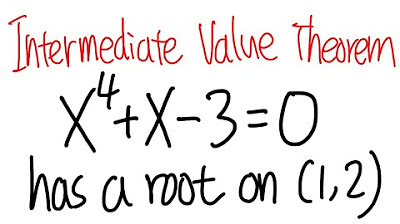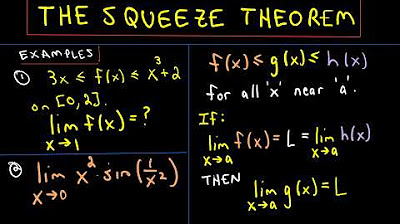Justification with the intermediate value theorem: equation | AP Calculus AB | Khan Academy
TLDRThe video script discusses the application of the Intermediate Value Theorem to the function g(x) = 1/x. It explains that g(x) is not continuous over the interval [-1, 1] due to its discontinuity at x=0, thus the theorem cannot be applied here to find a root where g(x) equals zero. However, for the interval [1, 2], the function is continuous, and since 3/4 lies between g(1) and g(2), the theorem confirms the existence of a solution to the equation g(x) = 3/4 within this interval.
Takeaways
- 📌 The function g(x) = 1/x is being discussed in relation to the Intermediate Value Theorem.
- 🔍 To apply the Intermediate Value Theorem, the function must be continuous over the interval of interest.
- ❌ The function g(x) is not continuous over the interval from -1 to 1 because it is undefined at x = 0.
- 👉 The Intermediate Value Theorem cannot be used for the interval [-1, 1] due to the discontinuity at x = 0.
- 🉑 For the interval [1, 2], the function g(x) is continuous since it is defined for all real numbers except x = 0.
- 📈 The function g(x) takes on values of 1 at x=1 and 0.5 at x=2, establishing a continuous range over [1, 2].
- 🌟 Rational functions like 1/x are continuous at all points in their domain, which supports the continuity of g(x) on [1, 2].
- 📊 Since 3/4 lies between g(1) and g(2), the Intermediate Value Theorem confirms a solution exists for g(x) = 3/4 within [1, 2].
- 🎯 The theorem can be used to determine the existence of a solution for an equation within a certain interval, provided the function is continuous there.
- ✔️ The example demonstrates the importance of checking the continuity of a function before applying the Intermediate Value Theorem.
Q & A
What is the function g(x) described in the transcript?
-The function g(x) described in the transcript is g(x) = 1/x.
Can the intermediate value theorem be applied to g(x) = 1/x over the interval from -1 to 1?
-No, the intermediate value theorem cannot be applied to g(x) = 1/x over the interval from -1 to 1 because the function is not continuous over this interval. It is not defined at x = 0.
Why is g(x) = 1/x not continuous over the interval from -1 to 1?
-g(x) = 1/x is not continuous over the interval from -1 to 1 because it has a discontinuity at x = 0, where the function is undefined.
What is the interval over which g(x) = 1/x is continuous?
-g(x) = 1/x is continuous over the intervals (-∞, 0) and (0, ∞), but not over the closed interval [-1, 1] because it is not defined at x = 0.
Can the intermediate value theorem be used to find a solution for g(x) = 3/4 within the interval [1, 2]?
-Yes, the intermediate value theorem can be used to find a solution for g(x) = 3/4 within the interval [1, 2] because g(x) = 1/x is continuous over this interval and 3/4 lies between g(1) and g(2).
What are the values of g(x) at the endpoints of the interval [1, 2]?
-The value of g(x) at the endpoint x = 1 is g(1) = 1, and at the endpoint x = 2 is g(2) = 1/2.
What does the intermediate value theorem state?
-The intermediate value theorem states that if a function is continuous over a closed interval [a, b], then it must take any value between f(a) and f(b) at least once within that interval.
What is the significance of the intermediate value theorem in mathematics?
-The intermediate value theorem is significant in mathematics because it helps to establish the existence of roots for continuous functions and provides a foundational result for the analysis of continuous functions.
How does the intermediate value theorem apply to the function g(x) = 1/x in the interval [1, 2]?
-The intermediate value theorem applies to the function g(x) = 1/x in the interval [1, 2] because the function is continuous over this interval, and 3/4 is a value between g(1) and g(2). Therefore, there must exist a value c in the interval [1, 2] such that g(c) = 3/4.
What is the role of the intermediate value theorem in solving equations?
-The intermediate value theorem plays a crucial role in solving equations by guaranteeing the existence of solutions for continuous functions over certain intervals, which can be useful in various mathematical and real-world applications.
Can you provide an example of a real-world application of the intermediate value theorem?
-An example of a real-world application of the intermediate value theorem is in determining the existence of equilibrium points in physics, such as finding the balance point of a lever or the wobbly table example mentioned in the transcript, where the theorem can be used to find the exact position where the table becomes stable.
How does the completeness property of real numbers relate to the intermediate value theorem?
-The completeness property of real numbers, which states that every non-empty set of real numbers that is bounded above has a least upper bound, is used in the proof of the intermediate value theorem. It ensures that there exists a real number that can serve as the value of c for which g(c) equals a given value k within the interval.
Outlines
📚 Intermediate Value Theorem and Continuity
The instructor discusses the application of the Intermediate Value Theorem to the function g(x) = 1/x. Initially, the question arises whether there exists a value 'c' such that g(c) equals zero, with 'c' being between -1 and 1. The instructor clarifies that the function is not continuous over the interval [-1, 1] due to the discontinuity at x=0, thus the theorem cannot be applied. Moving on, the instructor considers the interval [1, 2] and confirms the continuity of g(x) over this range. The function is defined for all real numbers except zero and, as a rational function, is continuous at all points within its domain. The values of g(1) and g(2) are calculated, and since 3/4 lies between these two values, the theorem confirms the existence of a solution for g(x) = 3/4 within the interval [1, 2].
Mindmap
Keywords
💡Intermediate Value Theorem
💡Continuous Function
💡Domain of a Function
💡Rational Functions
💡Root of a Function
💡Interval
💡Function Values
💡Not Defined
💡Closed Interval
💡Between
💡Solution
💡Endpoints
Highlights
The function g(x) = 1/x is discussed in relation to the Intermediate Value Theorem.
The Intermediate Value Theorem requires the function to be continuous over the interval of interest.
The interval of interest from x = -1 to x = 1 is identified, but the function is not continuous over this interval due to the discontinuity at x = 0.
The concept of a function being defined and continuous over a closed interval is discussed.
The second question considers the interval from x = 1 to x = 2, where the function g(x) is continuous.
The function g(x) is defined for all real numbers except x = 0, which is a key point for its continuity on the interval from 1 to 2.
Rational functions, like 1/x, are continuous at all points in their domain, which supports the continuity of g(x) on the interval.
The values of g(x) at the endpoints of the interval [1, 2] are calculated, with g(1) = 1 and g(2) = 1/2.
The Intermediate Value Theorem is applied to find a solution for g(x) = 3/4 within the interval [1, 2], as 3/4 lies between g(1) and g(2).
The conclusion is reached that there exists an x in the interval [1, 2] such that g(x) = 3/4, demonstrating the theorem's utility.
The discussion emphasizes the importance of a function's continuity and definition on an interval for the applicability of the theorem.
The problem-solving approach is methodical, starting with assessing continuity and then applying the theorem to find solutions.
The example illustrates the practical application of the Intermediate Value Theorem in solving equations involving rational functions.
The transcript provides a clear and concise explanation of the conditions under which the Intermediate Value Theorem can be used.
The solution process is well-structured, making it easy for learners to follow and understand the application of the theorem.
The discussion is relevant for anyone studying or reviewing the Intermediate Value Theorem and its conditions of applicability.
The transcript serves as a valuable resource for educational purposes, particularly in mathematics and the study of functions.
Transcripts
Browse More Related Video

Intermediate Value Theorem, calculus 1 tutorial, showing a root of a function on an interval

2019 AP Calculus AB Free Response Question #6

2011 Calculus AB free response #4a | AP Calculus AB | Khan Academy

Justification with the intermediate value theorem: table | AP Calculus AB | Khan Academy

2011 AP Calculus AB Free Response #4

The Squeeze Theorem for Limits, Example 1
5.0 / 5 (0 votes)
Thanks for rating: